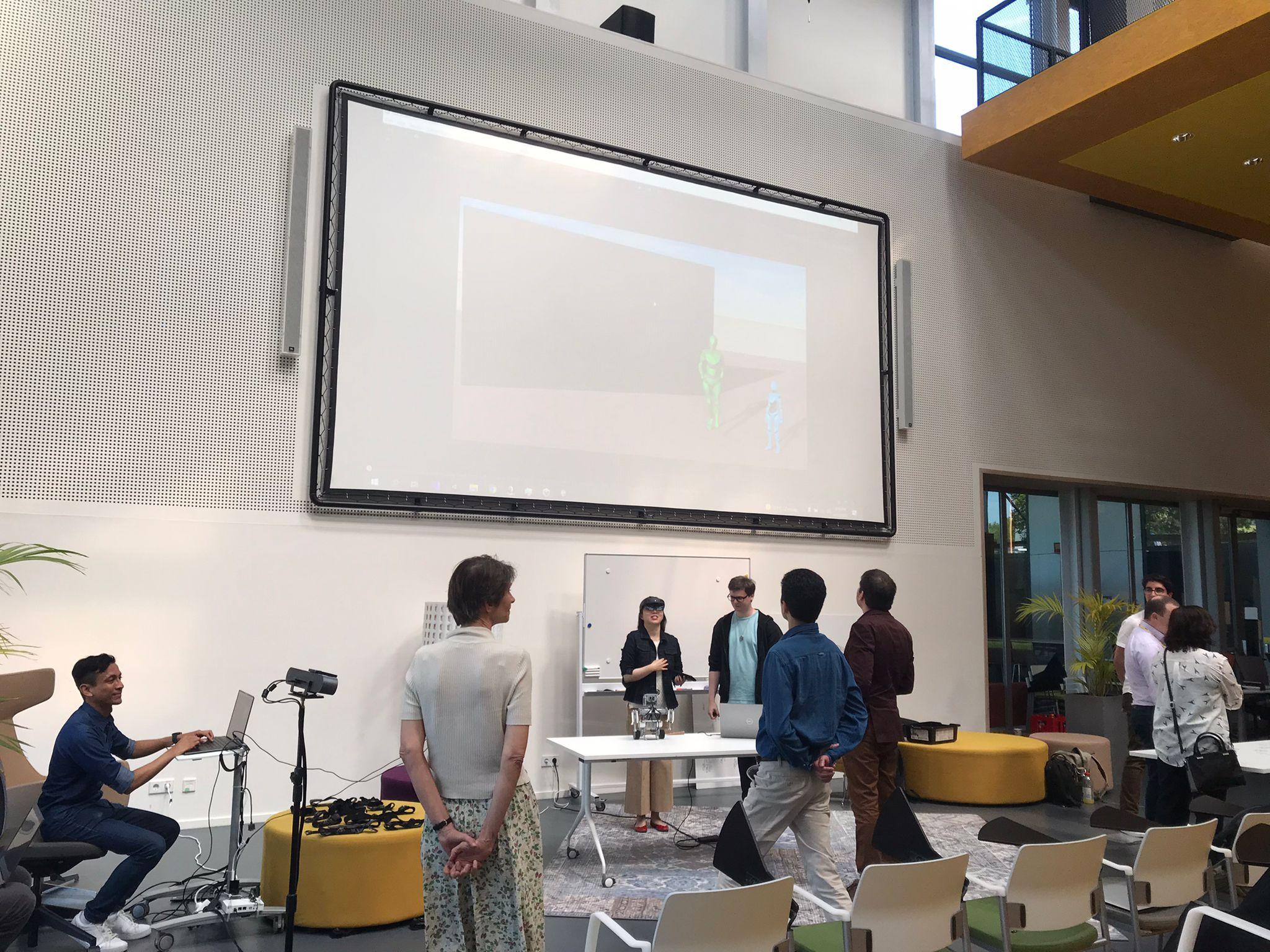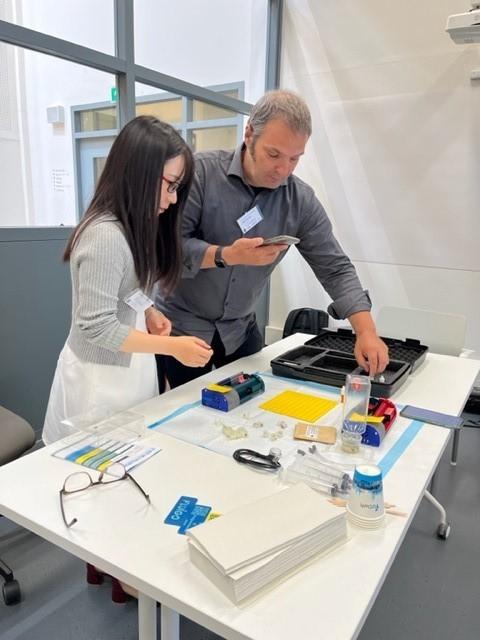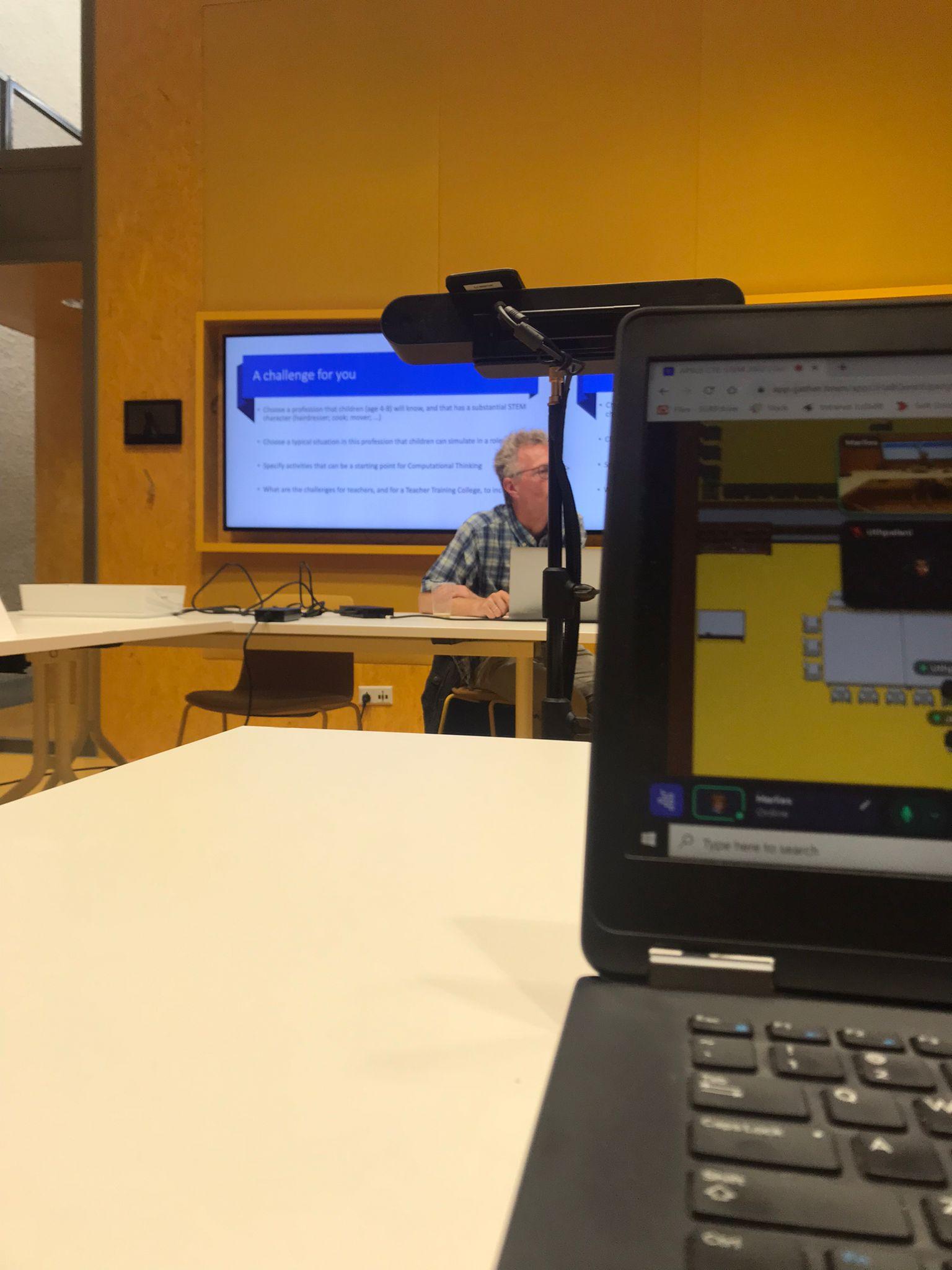The 6th APSCE CTE-STEM conference took place from 15-17 June 2022 at TU Delft. This conference was hybrid, onsite at the Teaching Academy and online in our GatherTown space. We welcomed visitors from all around the world; onsite around 25 visitors and in the virtual Teaching Lab also 25 visitors, whose avatars walked around and attended keynotes and workshops and were able to interact in between.
Day 1 - 15 June 2022
On the first day Siu Cheung Kong, Chee-kit Looi, and Marcus Specht welcomed the visitors to the 6th APSCE CTE-STEM conference. After a small coffee break, we started with the first two of six paper presentation sessions. We had presenters who were presenting onsite and also presenters who presented online. Thanks to our hybrid team, everybody was able to hear and see the all presenters.
The first keynote of this hybrid conference was Dr. Georgi Dimitrov, MBA, Head of Unit Digital Education, European Commission, Directorate General Education, and Culture. The title of his keynote: What does it mean to be digitally competent today and what can be done to improve the provision of digital skills in education and training?
After this keynote participants could choose between two workshops:
- 1. IMTSECT - Immersive Multimodal Technologies for STEAM Education and Computational Thinking. By: Khaleel Asyraaf Mat Sanusi, Daniel Majonica, Melina Rose | Open Universiteit & Cologne Game Lab,TH Köln
Immersive technologies, such as those used for virtual and augmented reality, allow to create virtual environments in which users are fully immersed into interactive spaces. Combined with methods of multimodal interaction, these immersive environments allow for simulating natural ways of communication and interaction of human beings and software systems.
For education in STEAM (Science, Technology, Engineering, Arts, Mathematics) or Computational Thinking, such technologies enable learners to explore complex phenomena in safe environments with a maximum of interaction and intensity.
Especially in fields, where interaction with real environments would be too expensive (such as learning with industry scale robots), too dangerous (such as certain experiments in chemistry), or simply not possible (such as traveling through time or space), immersive technologies can enable learning and training that would otherwise simply not be possible.
This workshop generally introduced immersive technologies and the principles of multimodal interaction. Along several examples from past and ongoing research and development projects, participants got to know the possibilities and benefits of immersive multimodal technologies for education and beyond.

- 2. FluiGo | Learn through play with the Flui.Go Kit | By: Flui.Go
Contents of the Flui.Go Kit look like a toy, but it’s more than that: it is an open-ended play system that uses creativity to make playing and learning a holistic and evolving experience. With the Flui.Go Kit STEM teachers are able to Teach scientific principles in a playful way, Develop critical thinking and problem-solving skills, Promote teamwork through collaboration when performing the experiments, Encourage imagination and curiosity and Capture the student's attention with a 'hands-on' approach.

During this workshop participants played with the kit and experienced how difficult chemical processes can be learned by doing.
Day 2 - 16 June 2022
The second day of the conference started with a keynote by Jens Mönig, researcher at SAP. All the way from Germany he enthusiastically presented his keynote onsite. During this keynote he presented SNAP!, a Scratch-like programming language that treats code-blocks as first-class citizens instead of confining them to an editing modality. Embracing nested data structures and higher order functions Snap! let’s learners create arbitrary control structures and even custom programming languages with just blocks. Snap! has been developed for UC Berkeley’s introductory computer science course named “The Beauty and Joy of Computing”.
After this keynote, we started with the third and fourth paper presentation sessions, which also consist out of online and onsite presenters. All proceedings can be found here.
The lunch break was followed up by the second keynote of the day:. From Rule-Driven to Data-Driven Computing Education in K-12 by Prof. Matti Tedre.
The popular approaches to K-12 computing education today are based on analysing and describing problems in a way that enables their solutions to be formulated as series of computational steps. Rule-based "classical" programming paradigms have come to dominate K-12 programming education, with some of their relevant key concepts and skills described under the title computational thinking (CT).
After the keynote, participants could choose between three workshops:
- 1. Computational thinking in STEM Education. By: Dr. Hanno van Keulen | associate professor and Director of Studies of the MSc Science Education & Communication at Delft University of Technology.
STEM is an acronym of Science, Technology, Engineering and Mathematics. It can pertain to any combination of the learning objectives and activities native to these disciplines. In a wider sense, STEM stresses the integral, holistic nature of many phenomena, objects and processes in the material world. Counting, computing, and programming, like observing, experimenting, hypothesizing, modelling, or causal reasoning is something that occurs naturally in many STEM activities in education. Computational thinking may be an objective in itself, or a means to achieve other attainment targets.
In this presentation, computational thinking in STEM was addressed in three different situations.
The first was the world of early childhood, where children learn predominantly through embodied perception and action. Notions like up and down, left and right, forward and backward are explored with the body and applied to manipulate artifacts, such as BeeBot, that can be programmed through pushing buttons.
The second example draws on an experiment in which children aged 9-14 with an Autism Spectrum Disorder (ASD) learned to build and program a robot (OzoBot, LegoMindstorms), to simulate shopping in a supermarket. They learned computational thinking, but more importantly, this task is a context to acquire social skills. Firstly, by collaborating in the technological and computational challenges, secondly, to solve challenges with a social character, like avoiding collisions with other customers-robots; asking for help to find out where empty bottles can be returned, et cetera.
The third example draws on design projects in upper secondary education in so-called Technasium schools. These schools provide students with real STEM projects, e.g., on the energy transition, water management, environmental hazards. Often, computational thinking and programming is part of the challenge.

- 2. Computational Thinking with your Hands. By: Dr. Nardie Fanchamps, Open University, the Netherlands & Dr. Christian Glahn, ZHAW, Switzerland
The development of computational thinking can be stimulated by means of a variety of unplugged and plugged-in applications, programming environments and materials. Educational robots are equipped with sensors and motors that can be programmed to use the sense-reason-act (SRA) approach. However, in physical computing programming is not limited to writing computer code or software. Physical computing also allows programming with hardware and the environment. This generates opportunities for students who have not fully developed competences to abstract processes into steps and rules. Moreover, using the environment as a programming platform allows for new and natural approaches cooperation, collaboration, and competition in the computational thinking classroom.
In this hands-on, tangible physical computing workshop we have used the environment to program robots. It clarifies the impact of learning to program robots on cognitive development of computational thinking as a creative task.
Physical computing refers to approaches of using computers to work in and interact with the environment. Often computers in physical computing lack a traditional display, mouse, and keyboard but are equipped with sensors, buttons, speakers, and motors. Today we find physical computing applications in smart speakers, smart lightbulbs, or even robots. Learning to control smart devices on different levels is key for responsible and democratic innovation.
The construct of SRA-programming is a supportive process that combines external, sensor-based measurements (sense), computing devices to process these measurements (reason), and executing desired actions as outcomes (act). The ability to anticipate changing conditions in the task design through sensor-based observations requires a different programming approach in comparison to linear, sequential solutions. While this approach is suitable for linking to the more traditional approaches of teaching programming in schools, it involves abstractions of using data and hardware at different levels. In this workshop we explored learning activities that help students to learn and develop these abstractions by using creativity, cooperation, and collaboration.
- 3. Hedy: A gradual programming language. By: Marleen Gilsing
Many teachers want to teach programming to their pupils today, but how to approach it? Block-based languages like Scratch are great for the first steps, but at one point, you want to move on to textual languages such as Python. Python however is quite hard for kids to get started with since it is a language for professional programmers.
Hedy (www.hedycode.com) is the solution for this problem! The core idea of Hedy is that it uses different language levels. In level 1, there is hardly any syntax at all, for example, printing is done with:
‘print hello teachers at CSE-STEM!’
In every level, new syntax and concepts are added, until kids are doing a subset of Python in level 20 with conditions, loops, variables and lists. The levelled approach means that learners do not have to learn all syntax rules at once. Hedy is aimed at children that want to get started with textual programming languages, but for whom starting with Python might still be too complex. Hedy runs in the browser, is free to use and comes with built-in lesson plans, ready to use. It also has a special teacher's interface in which you can create classes and customise which assignments your students can work on.
After all those interesting and inspiring events, it was time to head to the beach for the social event: a barbeque at the beach. The food was good, the weather was good and the nice company made it a successful social event
Day 3 - 17 June 2022
The last day of the conference started with the last keynote from Prof. Maarten de Laat, Centre for Change and Complexity in Learning, University of South Australia. His keynote was about: AI in the Classroom – Students Collaborating with AI to Solve Complex Problems
Applications of artificial intelligence (AI) are set to transform society, including how people work and learn. This growing ubiquity of AI in society poses significant challenges for educational systems: what will citizens in the 21st century need to know about, and do with, AI? Currently, there is very little research and experience on how schools and teachers adopt AI into the classroom and how our students work and learn together with AI.
After the interesting keynote of Maarten and a great lunch it was time for the last two paper presentation sessions.
All good things must come to an end, so after all the great inspiring presentations, keynotes and workshops it was time for the closing ceremony. Next year conference will be held at Taiwan. Thanks everybody for participating online and onsite on this year’s conference and we will see you all next year in Taiwan.
